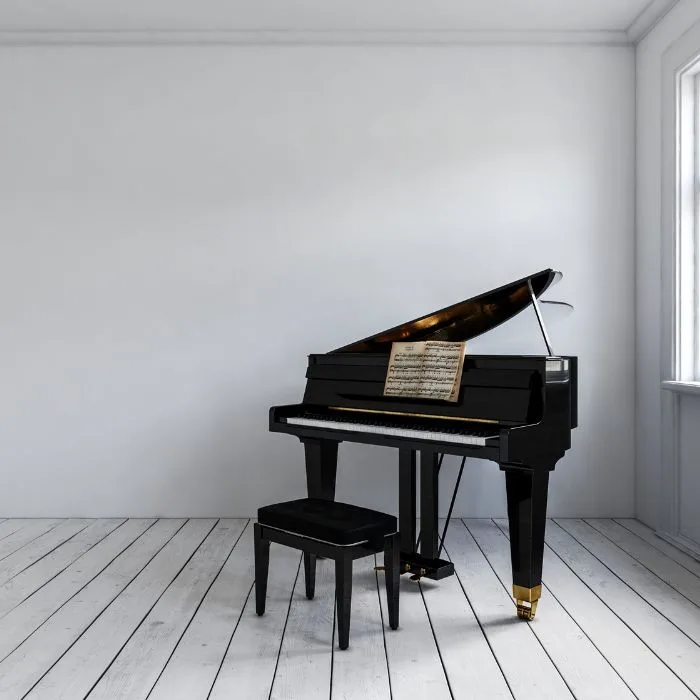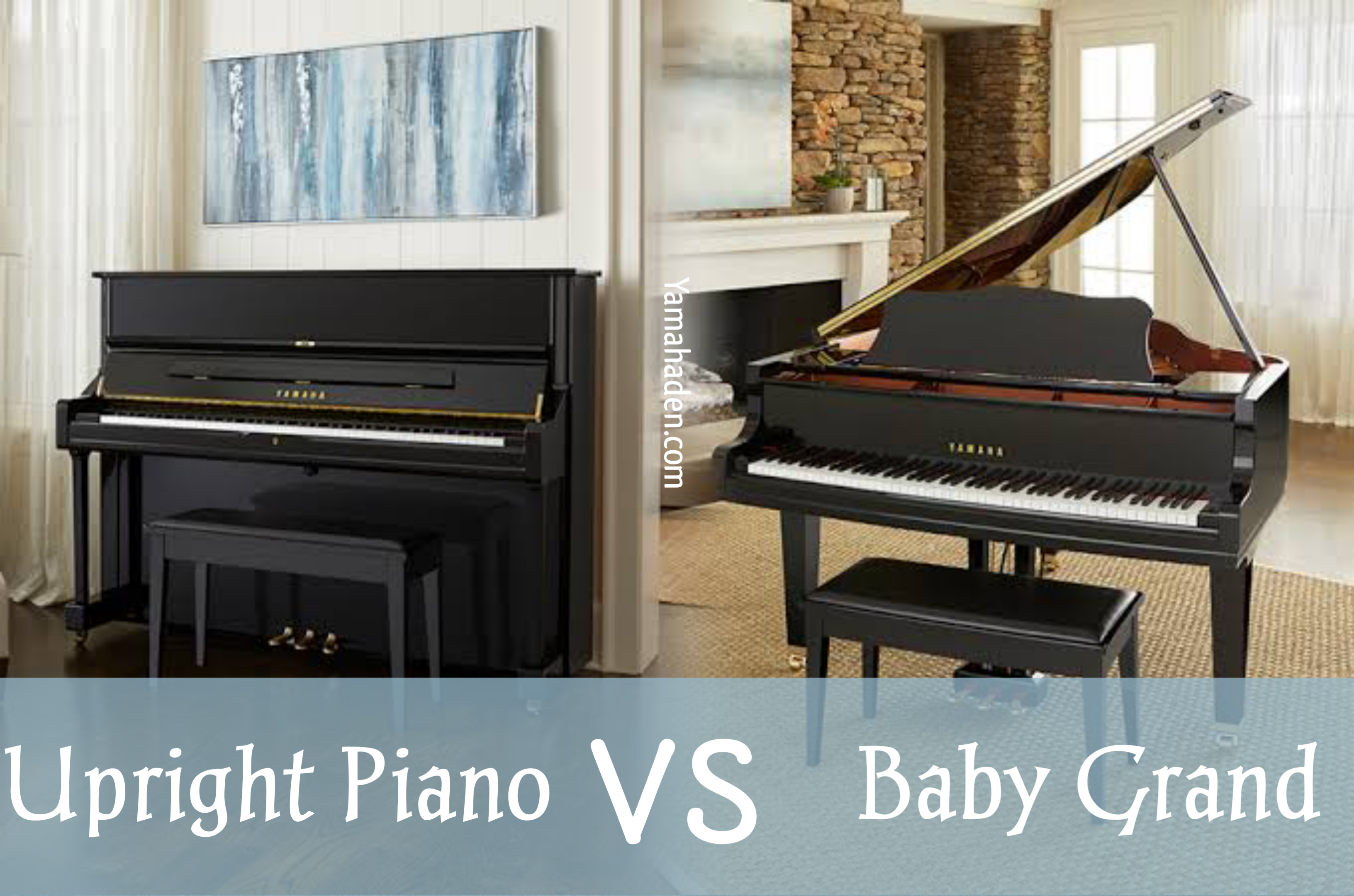Are you torn between buying a baby grand or an upright piano? As a lifelong pianist and music educator, I understand the struggle of choosing the right instrument. With so many factors to consider, it can be overwhelming and confusing. But fear not, because in this expert guide, I’ll take you through everything you need to know about these two popular types of pianos.
From their size and sound to their price range and maintenance requirements, we’ll cover all the key differences between baby grands and uprights. Whether you’re a beginner looking for your first piano or an experienced player wanting to upgrade, this article is for you! So grab your favorite beverage, sit back, and let’s explore which type of piano is best suited for you.
So, baby grand vs upright?
It ultimately depends on your personal preferences and needs. The baby grand piano is known for its elegant appearance and rich sound, making it a popular choice for professional musicians and those looking to make a statement in their home. However, the upright piano offers a more compact size, making it ideal for smaller spaces or beginner pianists.
If you value aesthetics and have the space for it, the baby grand may be the right choice for you. Its longer strings allow for better resonance and tone quality compared to an upright piano. It also has a wider range of notes which can enhance your playing experience.
On the other hand, if space is limited or you are just starting out with learning how to play the piano, an upright may be more practical. It takes up less room while still producing decent sound quality. Additionally, upright pianos tend to be less expensive than baby grands.
Ultimately, both types of pianos offer unique benefits and it’s important to consider your own needs before making a decision. If possible, try playing both types of pianos before deciding which one feels most comfortable and sounds best to you.
Understanding the Key Differences Between a Baby Grand and Upright Piano
When it comes to pianos, the difference between a baby grand and an upright piano isn’t just about their size. They each have unique qualities that cater to different needs. The most noticeable distinction is in their shape and structure. A baby grand has a horizontal frame with strings stretching out flat, resembling a wing or bird’s tail when seen from above. This not only gives it an elegant appearance but also contributes to its superior sound quality. The longer strings allow for richer bass tones and brighter high notes, making it ideal for performances where sound clarity is paramount.
On the other hand, upright pianos are designed vertically with strings standing up straight against the wall. This compact design makes them perfect for smaller spaces like apartments or classrooms since they take up less room while still producing beautiful music. While they may not offer the same depth of tone as a baby grand, modern uprights can surprise you with their impressive range and volume capabilities due to advancements in technology over the years. Additionally, because of their vertical build:
- They are generally easier to maintain.
- Tuning tends to be more straightforward.
- They’re often more affordable than grands.
In essence, choosing between these two types comes down to your space constraints, budget considerations, and what kind of musical experience you’re looking for!
Exploring the Sound Quality of Baby Grand vs Upright Pianos
Hearing the difference between a baby grand and an upright piano is like comparing the gentle rustle of leaves to a powerful gust of wind. The baby grand sings with elegance, its soundboard stretching out horizontally, allowing vibrations to resonate freely within its body. These vibrations create rich, full tones that seem to float in the air, filling rooms with warmth and depth. When you press a key on a baby grand, the hammers strike strings that are longer and positioned more naturally, resulting in consistent touch and response.
In contrast, upright pianos have their own unique charm. They fit snugly against walls yet still manage to produce melodious tunes suitable for smaller spaces or intimate gatherings. Their vertical design makes them compact without sacrificing too much tonal quality; however, every note feels slightly different due to shorter strings and tighter spacing inside its wooden frame.
Despite these differences:
- Upright pianos: Practical for homes where space is limited.
- Baby grands: Offer superior sound but require ample room.
Ultimately, your choice between these two beloved instruments may come down not just to sound but also to personal preference and available space.
Read also: yamaha electric guitars
Analyzing the Size and Space Requirements for Both Baby Grand and Upright Pianos
When it comes to choosing the perfect piano for your home, understanding size and space requirements can make all the difference. Baby grand pianos, with their elegant curves and beautiful sound, often become a room’s centerpiece. They typically range from 4’11” to 5’6″ in length and can take up quite a bit of space—not just horizontally but also visually dominating any area they inhabit. You’ll need at least an additional three feet around it for both benches and players to move comfortably. This means that a sizeable living room or dedicated music room is usually required.
On the other hand, upright pianos are much more versatile when it comes to fitting into tighter spaces without compromising on musical quality. These types generally stand between 3’6″ and 4’6″ high while only extending roughly two feet deep from front to back. Due to their compact nature, they fit nicely against walls or into corners of rooms, making them ideal for apartments or smaller homes where every square foot counts. The vertical strings still provide rich tones but within manageable dimensions.
- Baby Grand Pianos:
- Dimensions: ~4’11” – 5’6” in length
- Total Space Needed: Roomy area plus extra walking space
- Upright Pianos:
- Dimensions: ~3’6” – 4’6” high; ~2 ft deep
- Total Space Needed: Fits well against walls/corners
If you’re deciding between these two options consider not just your available floor plan but also how each style contributes its unique aesthetic presence.

Considering the Price Range and Maintenance Costs: Is a Baby Grand or Upright Piano More Affordable?
When it comes to choosing between a baby grand and an upright piano, affordability is often a big factor. Baby grands are elegant and produce rich sound, but they come with a hefty price tag. These pianos can cost anywhere from $8,000 to over $100,000 depending on the brand and craftsmanship. Additionally, their larger size means you’ll need more space at home which could be another hidden expense if your current setup isn’t spacious enough.
On the other hand, upright pianos tend to be more budget-friendly. You can find decent models starting around $3,000 with high-end options going up to about $20,000. Maintenance costs also differ significantly between these two types of pianos:
- Baby grands require tuning every six months due to their intricate design.
- Uprights generally need less frequent tuning—usually once a year.
Another thing to consider is that repairs for baby grands can be pricier because they have more complex mechanisms compared to uprights.
So while both types bring beautiful music into your home, understanding the initial purchase price and long-term maintenance costs will help determine what fits best within your budget.
If you’re looking for something affordable yet reliable without sacrificing too much on quality or aesthetics, an upright piano might just hit all the right notes for you.
You may also like: mason and hamlin piano
Choosing Your Ideal Instrument: Factors to Consider When Deciding Between a Baby Grand and an Upright Piano
When you’re trying to decide between a baby grand and an upright piano, there are several factors to keep in mind. Sound quality is one of the most important aspects. Baby grands tend to have a richer, more resonant sound due to their larger size and shape. The horizontal strings allow for better vibration, which often results in a fuller tone. In contrast, uprights have vertical strings that limit the resonance but can still produce beautiful music. If space or budget constraints don’t limit you, the baby grand might be your best bet for achieving that rich sound.
On the other hand, consider your available space and how much room you can dedicate to this musical addition. Upright pianos are typically more compact and fit neatly against walls or in small nooks without taking up too much floor space—they’re great if you live in an apartment or smaller home. Baby grands require more room both horizontally and vertically; they become focal points wherever they’re placed due to their elegant design and size.
– Budget: Generally speaking, baby grands are pricier than upright pianos.
– Purpose: Are you playing casually at home or preparing for professional gigs?
– Maintenance: Both types need regular tuning but bear different upkeep costs.
Balancing these considerations will help guide you toward making a well-informed choice that’s perfect for your musical journey!
Making an Informed Choice between a Baby Grand and an Upright Piano
Choosing between a baby grand and an upright piano can be thrilling yet challenging. The baby grand, with its elegant curves and rich sound, often stands as a symbol of musical excellence. Its horizontal strings allow for longer resonance, which means each note lingers beautifully in the air. This model also has a responsive touch that allows pianists to express nuances in their music effortlessly. However, it does require more space—a factor not everyone might have the luxury of accommodating.
On the other hand, upright pianos offer compactness while still providing quality sound and touch. They fit snugly against walls or corners, making them ideal for smaller homes or apartments. Uprights tend to be more budget-friendly than baby grands, opening doors for aspiring musicians who are conscious about cost but not willing to compromise on passion. Despite their vertical design limiting string length—and thus affecting some tonal depth—modern uprights can surprise you with their robustness and clarity.
When deciding between these two options:
- Consider your available space.
- Think about your budget.
- Ponder how much you value tonal quality vs convenience.
Weighing these factors carefully will help ensure that your choice brings joy every time you sit down to play.

